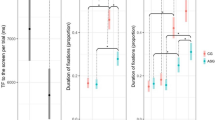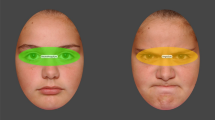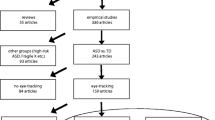Abstract
Eye-tracking studies have demonstrated mixed support for reduced eye fixation when looking at social scenes in individuals with Autism Spectrum Conditions (ASC). We present evidence that these mixed findings are due to a separate condition—alexithymia—that is frequently comorbid with ASC. We find that in adults with ASC, autism symptom severity correlated negatively with attention to faces when watching video clips. However, only the degree of alexithymia, and not autism symptom severity, predicted eye fixation. As well as potentially resolving the contradictory evidence in this area, these findings suggest that individuals with ASC and alexithymia may form a sub-group of individuals with ASC, with emotional impairments in addition to the social impairments characteristic of ASC.


Similar content being viewed by others
References
Adolphs, R., Gosselin, F., Buchanan, T. W., Tranel, D., Schyns, P., & Damasio, A. R. (2005). A mechanism for impaired fear recognition after amygdala damage. Nature, 433(7021), 68–72.
American Psychiatric Association (2000). Diagnostic and statistical manual of mental disorders, DSM-IV-TR, 4th ed., text revision. Washington, D.C.
Aviezer, H., Hassin, R. R., Ryan, J., Grady, C., Susskind, J., Anderson, A., et al. (2008). Angry, disgusted, or afraid? Studies on the malleability of emotion perception. Psychological Science, 19(7), 724–732.
Bagby, R. M., Taylor, G. J., & Parker, J. D. (1994). The twenty-item Toronto alexithymia scale–II. Convergent, discriminant, and concurrent validity. Journal of Psychosomatic Research, 38(1), 33–40.
Bal, E., Harden, E., Lamb, D., Van Hecke, A. V., Denver, J. W., & Porges, S. W. (2010). Emotion recognition in children with autism spectrum disorders: Relations to eye gaze and autonomic state. Journal of Autism and Developmental Disorders, 40(3), 358–370.
Baranek, G. T. (1999). Autism during infancy: A retrospective video analysis of sensory-motor and social behaviors at 9–12 months of age. Journal of Autism and Developmental Disorders, 29(3), 213–224.
Baron-Cohen, S. (1994). How to build a baby that can read minds—cognitive mechanisms in mindreading. Cahiers De Psychologie Cognitive-Current Psychology of Cognition, 13(5), 513–552.
Baron-Cohen, S., Jolliffe, T., Mortimore, C., & Robertson, M. (1997). Another advanced test of theory of mind: Evidence from very high functioning adults with autism or Asperger syndrome. Journal of Child Psychology and Psychiatry and Allied Disciplines, 38(7), 813–822.
Berthoz, S., & Hill, E. L. (2005). The validity of using self-reports to assess emotion regulation abilities in adults with autism spectrum disorder. European Psychiatry, 20(3), 291–298.
Bird, G., Silani, G., Brindley, R., White, S., Frith, U., & Singer, T. (2010). Empathic brain responses in insula are modulated by levels of alexithymia but not autism. Brain, 133(Pt 5), 1515–1525.
Birmingham, E., Bischof, W. F., & Kingstone, A. (2008). Social attention and real-world scenes: The roles of action, competition and social content. Quarterly Journal of Experimental Psychology, 61(7), 986–998.
Boraston, Z. L., Corden, B., Miles, L. K., Skuse, D. H., & Blakemore, S. J. (2008). Brief report: Perception of genuine and posed smiles by individuals with autism. Journal of Autism and Developmental Disorders, 38(3), 574–580.
Buitelaar, J. K. (1995). Attachment and social withdrawal in autism—hypotheses and findings. Behaviour, 132, 319–350.
Calder, A. J., Young, A. W., Keane, J., & Dean, M. (2000). Configural information in facial expression perception. Journal of Experimental Psychology: Human Perception and Performance, 26, 527–551.
Cassel, T. D., Messinger, D. S., Ibanez, L. V., Haltigan, J. D., Acosta, S. I., & Buchman, A. C. (2007). Early social and emotional communication in the infant siblings of children with autism spectrum disorders: An examination of the broad phenotype. Journal of Autism and Developmental Disorders, 37(1), 122–132.
Chawarska, K., & Shic, F. (2009). Looking but not seeing: Atypical visual scanning and recognition of faces in 2 and 4-year-old children with autism spectrum disorder. Journal of Autism and Developmental Disorders, 39(12), 1663–1672.
Corden, B., Chilvers, R., & Skuse, D. (2008). Avoidance of emotionally arousing stimuli predicts social-perceptual impairment in Asperger’s syndrome. Neuropsychologia, 46(1), 137–147.
Dadds, M. R., El Masry, Y., Wimalaweera, S., & Guastella, A. J. (2008). Reduced eye gaze explains “Fear Blindness” in childhood psychopathic traits. Journal of the American Academy of Child and Adolescent Psychiatry, 47(4), 455–463.
Dalton, K. M., Holsen, L., Abbeduto, L., & Davidson, R. J. (2008). Brain function and gaze fixation during facial-emotion processing in fragile X and autism. Autism Research, 1(4), 231–239.
Dalton, K. M., Nacewicz, B. M., Alexander, A. L., & Davidson, R. J. (2006). Gaze-fixation, brain activation, and amygdala volume in unaffected siblings of individuals with autism. Biological Psychiatry, 61, 512–520.
Dalton, K. M., Nacewicz, B. M., Johnstone, T., Schaefer, H. S., Gernsbacher, M. A., Goldsmith, H. H., et al. (2005). Gaze fixation and the neural circuitry of face processing in autism. Nature Neuroscience, 8(4), 519–526.
Dapretto, M., Davies, M. S., Pfeifer, J. H., Scott, A. A., Sigman, M., Bookheimer, S. Y., et al. (2006). Understanding emotions in others: Mirror neuron dysfunction in children with autism spectrum disorders. Nature Neuroscience, 9(1), 28–30.
Dimberg, U., & Petterson, M. (2000). Facial reactions to happy and angry facial expressions: Evidence for right hemisphere dominance. Psychophysiology, 37(5), 693–696.
Elsabbagh, M., Volein, A., Csibra, G., Holmboe, K., Garwood, H., Tucker, L., et al. (2009). Neural correlates of eye gaze processing in the infant broader autism phenotype. Biological Psychiatry, 65(1), 31–38.
Exline, R. (1971). Visual interaction. The glances of power and preferences. Nebraska Symposium on Motivation, 19, 163–206.
Falck-Ytter, T., Fernell, E., Gillberg, C., & Von Hofsten, C. (2010). Face scanning distinguishes social from comunication impairments in autism. Developmental Science, 13(6), 864–875.
Fletcher-Watson, S., Leekam, S. R., Benson, V., Frank, M. C., & Findlay, J. M. (2009). Eye-movements reveal attention to social information in autism spectrum disorder. Neuropsychologia, 47(1), 248–257.
Freeth, M., Chapman, P., Ropar, D., & Mitchell, P. (2010). Do gaze cues in complex scenes capture and direct the attention of high functioning adolescents with ASD? Evidence from eye-tracking. Journal of Autism and Developmental Disorders, 40(5), 534–547.
Haith, M. M., Bergman, T., & Moore, M. J. (1979). Eye contact and face scanning in early infancy. Science, 198, 853–854.
Hernandez, N., Metzger, A., Magne, R., Bonnet-Brilhaut, F., Roux, S., Barthelemy, C., et al. (2009). Exploration of core features of a human face by healthy and autistic adults analyzed by visual scanning. Neuropsychologia, 47(4), 1004–1012.
Hill, E., Berthoz, S., & Frith, U. (2004). Brief report: Cognitive processing of own emotions in individuals with autistic spectrum disorder and in their relatives. Journal of Autism and Developmental Disorders, 34(2), 229–235.
Horley, K., Williams, L. M., Gonsalvez, C., & Gordon, E. (2003). Social phobics do not see eye to eye: A visual scanpath study of emotional expression processing. Journal of Anxiety Disorders, 17(1), 33–44.
Horley, K., Williams, L. M., Gonsalvez, C., & Gordon, E. (2004). Face to face: Visual scanpath evidence for abnormal processing of facial expressions in social phobia. Psychiatry Research, 127(1–2), 43–53.
Hutt, C., & Ounsted, C. (1966). Biological significance of gaze aversion with particular reference to syndrome of infantile autism. Behavioral Science, 11(5), 346–356.
Jemel, B., Mottron, L., & Dawson, M. (2006). Impaired face processing in autism: Fact or artifact? Journal of Autism and Developmental Disorders, 36(1), 91–106.
Jessimer, M., & Markham, R. (1997). Alexithymia: A right hemisphere dysfunction specific to recognition of certain facial expressions? Brain and Cognition, 34(2), 246–258.
Johnson, M., Dziurawiec, S., Ellis, H. D., & Morton, J. (1991). Newborns’ preferential tracking of face-like stimuli and its subsequent decline. Cognition, 40, 1–19.
Jones, W., Carr, K., & Klin, A. (2008). Absence of preferential looking to the eyes of approaching adults predicts level of social disability in 2-year-old toddlers with autism spectrum disorder. Archives of General Psychiatry, 65(8), 946–954.
Joseph, R. M., & Tanaka, J. (2003). Holistic and part-based face recognition in children with autism. Journal of Child Psychology and Psychiatry and Allied Disciplines, 44(4), 529–542.
Kanner, L. (1943). Autistic disturbances of affective contact. Nervous Child, 2, 217–250.
Kanner, L. (1944). Early infantile autism. Journal Paediatrics, 25, 211–217.
Kendon, A. (1967). Some functions of gaze-direction in social interaction. Acta Psychologica, 26(1), 22–63.
Klin, A., Jones, W., Schultz, R., Volkmar, F., & Cohen, D. (2002). Visual fixation patterns during viewing of naturalistic social situations as predictors of social competence in individuals with autism. Archives of General Psychiatry, 59(9), 809–816.
Klin, A., Lin, D. J., Gorrindo, P., Ramsay, G., & Jones, W. (2009). Two-year-olds with autism orient to nonsocial contingencies rather than biological motion. Nature, 459(7244), 257–261.
Lahaie, A., Mottron, L., Arguin, M., Berthiaume, C., Jemel, B., & Saumier, D. (2006). An investigation of configural and part-based face processing in high-functioning autism. Journal of Neuropsychology, 20, 30–41.
Lane, R. D., Sechrest, L., Reidel, R., Weldon, V., Kaszniak, A., & Schwartz, G. E. (1996). Impaired verbal and nonverbal emotion recognition in alexithymia. Psychosomatic Medicine, 58(3), 203–210.
Lane, R. D., Sechrest, L., Riedel, R., Shapiro, D. E., & Kaszniak, A. W. (2000). Pervasive emotion recognition deficit common to alexithymia and the repressive coping style. Psychosomatic Medicine, 62(4), 492–501.
Linden, W., Wen, F., & Paulhus, D. L. (1995). Measuring alexithymia: Reliability, validity, and prevalence. In J. Butcher & C. Spielberger (Eds.), Advances in personality assessment (pp. 51–95). Hillsdale, NJ: Earlbaum.
Lombardo, M. V., Barnes, J. L., Wheelwright, S. J., & Baron-Cohen, S. (2007). Self-referential cognition and empathy in autism. PLoS One, 2(9), e883.
Lord, C., Risi, S., Lambrecht, L., Cook, E. H., Leventhal, B. L., DiLavore, P. C., et al. (2000). The autism diagnostic observation schedule-generic: A standard measure of social and communication deficits associated with the spectrum of autism. Journal of Autism and Developmental Disorders, 30(3), 205–223.
Loughland, C. M., Williams, L. M., & Gordon, E. (2002). Schizophrenia and affective disorder show different visual scanning behavior for faces: A trait versus state-based distinction? Biological Psychiatry, 52(4), 338–348.
Mann, L. S., Wise, T. N., Trinidad, A., & Kohanski, R. (1994). Alexithymia, affect recognition, and the five-factor model of personality in normal subjects. Psychological Reports, 74(2), 563–567.
Maurer, D., & Salapatek, P. (1976). Developmental changes in the scanning of faces by young infants. Child Development, 47, 523–527.
Mazzola, F., Seigal, A., MacAskill, A., Corden, B., Lawrence, K., & Skuse, D. H. (2006). Eye tracking and fear recognition deficits in Turner syndrome. Social Neuroscience, 1(3–4), 259–269.
Morton, J., & Johnson, M. H. (1991). Conspec and conlern—a 2-process theory of infant face recognition. Psychological Review, 98(2), 164–181.
Nemiah, J. C., Freyberger, H., & Sifneos, P. E. (1976). Alexithymia: A view of the psychosomatic process. In O. W. Hill (Ed.), Modern trends in psychosomatic medicine (pp. 430–439). London: Butterworths.
Neumann, D., Spezio, M. L., Piven, J., & Adolphs, R. (2006). Looking you in the mouth: Abnormal gaze in autism resulting from impaired top-down modulation of visual attention. Social Cognitive and Affective Neuroscience, 1, 194–202.
O’Connor, N., & Hermelin, B. (1967). The selective visual attention of psychotic children. Journal of Child Psychology and Psychiatry, 8, 167–179.
Osterling, J., & Dawson, G. (1994). Early recognition of children with autism—a study of 1st birthday home videotapes. Journal of Autism and Developmental Disorders, 24(3), 247–257.
Osterling, J. A., Dawson, G., & Munson, J. A. (2002). Early recognition of 1-year-old infants with autism spectrum disorder versus mental retardation. Development and Psychopathology, 14(2), 239–251.
Parker, J. D., Taylor, G. J., & Bagby, R. M. (1993). Alexithymia and the recognition of facial expressions of emotion. Psychotherapy and Psychosomatics, 59(3–4), 197–202.
Pelphrey, K. A., Sasson, N. J., Reznick, J. S., Paul, G., Goldman, B. D., & Piven, J. (2002). Visual scanning of faces in autism. Journal of Autism and Developmental Disorders, 32(4), 249–261.
Phillips, M. L., & David, A. S. (1997). Visual scan paths are abnormal in deluded schizophrenics. Neuropsychologia, 35(1), 99–105.
Preston, S. D., & de Waal, F. B. M. (2002). Empathy: Its ultimate and proximate bases. Behavioral and Brain Sciences, 25(1), 1–72.
Prkachin, G. C., Casey, C., & Prkachin, K. M. (2009). Alexithymia and perception of emotional facial expressions. Personality and Individual Differences, 46, 412–417.
Riby, D. M., & Hancock, P. J. B. (2008). Viewing it differently: Social scene perception in Williams syndrome and autism. Neuropsychologia, 46(11), 2855–2860.
Riby, D. M., & Hancock, P. J. B. (2009). Do faces capture the attention of individuals with Williams syndrome or autism? Evidence from tracking eye movements. Journal of Autism and Developmental Disorders, 39(3), 421–431.
Rutherford, M. D., & Towns, A. M. (2008). Scan path differences and similarities during emotion perception in those with and without autism spectrum disorders. Journal of Autism and Developmental Disorders, 38(7), 1371–1381.
Salminen, J. K., Saarijarvi, S., Aarela, E., Toikka, T., & Kauhanen, J. (1999). Prevalence of alexithymia and its association with sociodemographic variables in the general population of Finland. Journal of Psychosomatic Research, 46(1), 75–82.
Sasson, N., Tsuchiya, N., Hurley, R., Couture, S. M., Penn, D. L., Adolphs, R., et al. (2007). Orienting to social stimuli differentiates social cognitive impairment in autism and schizophrenia. Neuropsychologia, 45(11), 2580–2588.
Senju, A., & Johnson, M. H. (2009a). Atypical eye contact in autism: Models, mechanisms and development. Neuroscience and Biobehavioral Reviews, 33(8), 1204–1214.
Senju, A., & Johnson, M. H. (2009b). The eye contact effect: Mechanisms and development. Trends in Cognitive Sciences, 13(3), 127–134.
Silani, G., Bird, G., Brindley, R., Singer, T., Frith, C., & Frith, U. (2008). Levels of emotional awareness and autism: An fMRI study. Society for Neuroscience, 3(2), 97–112.
Smith, M. L., Cottrell, G. W., Gosselin, F., & Schyns, P. G. (2005). Transmitting and decoding facial expressions. Psychological Science, 16(3), 184–189.
Speer, L. L., Cook, A. E., McMahon, W. M., & Clark, E. (2007). Face processing in children with autism—effects of stimulus contents and type. Autism, 11(3), 265–277.
Spezio, M. L., Adolphs, R., Hurley, R. S. E., & Piven, J. (2007). Analysis of face gaze in autism using “Bubbles”. Neuropsychologia, 45(1), 144–151.
Sterling, L., Dawson, G., Webb, S., Murias, M., Munson, J., Panagiotides, H., et al. (2008). The role of face familiarity in eye tracking of faces by individuals with autism spectrum disorders. Journal of Autism and Developmental Disorders, 38(9), 1666–1675.
Trepagnier, C., Sebrechts, M. M., & Peterson, R. (2002). Atypical face gaze in autism. Cyberpsychology and Behavior, 5(3), 213–217.
van der Geest, J. N., Kemner, C., Verbaten, M. N., & van Engeland, H. (2002). Gaze behavior of children with pervasive developmental disorder towards human faces: A fixation time study. Journal of Child Psychology and Psychiatry, 43(5), 669–678.
Walkersmith, G. J., Gale, A. G., & Findlay, J. M. (1977). Eye-movement strategies involved in face perception. Perception, 6(3), 313–326.
Wechsler, D. (1999). Wechsler adult intelligence scale—3rd UK edition (WAIS III UK). London: The Psychological Corporation.
Wong, B., Cronin-Golomb, A., & Neargarder, S. (2005). Patterns of visual scanning as predictors of emotion identification in normal aging. Neuropsychology, 19, 739–749.
Yarbus, A. (1967). Eye Movement and Vision. New York.: Plenum.
Yirmiya, N., Gamliel, I., Pilowsky, T., Feldman, R., Baron-Cohen, S., & Sigman, M. (2006). The development of siblings of children with autism at 4 and 14 months: Social engagement, communication, and cognition. Journal of Child Psychology and Psychiatry, 47, 511–523.
Young, G. S., Merin, N., Rogers, S. J., & Ozonoff, S. (2009). Gaze behavior and affect at 6 months: Predicting clinical outcomes and language development in typically developing infants and infants at risk for autism. Developmental Science, 12(5), 798–814.
Acknowledgments
The authors wish to acknowledge the help of Jennifer Cook in administering the ADOS, conducting the IQ tests, and testing participants. We also wish to thank the volunteers who participated in this study.
Author information
Authors and Affiliations
Corresponding author
Rights and permissions
About this article
Cite this article
Bird, G., Press, C. & Richardson, D.C. The Role of Alexithymia in Reduced Eye-Fixation in Autism Spectrum Conditions. J Autism Dev Disord 41, 1556–1564 (2011). https://doi.org/10.1007/s10803-011-1183-3
Published:
Issue Date:
DOI: https://doi.org/10.1007/s10803-011-1183-3




